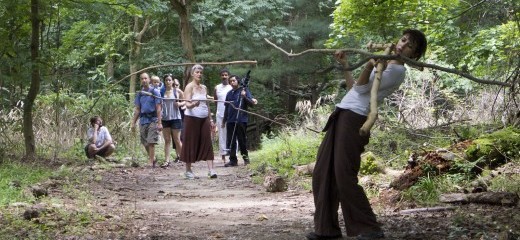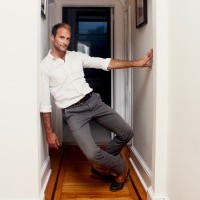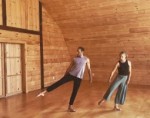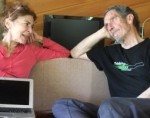
Photo: Gabriel Martinez
In Conversation with Merián Soto
by Beau Hancock
Bessie-award winning artist and Temple University dance professor Merián Soto’s diverse artistic endeavors range from the glacially paced Branch
Dances series (of which the recently performed
SoMoS was the culmination) to the exuberant Latin rhythms in
El Maquina del Tiempo. The following is a transcript of a discussion with Soto on her influences and interests, on teaching improvisation and the possibilities of the body.
B: What was the genesis of your course Corporeal Improvisation?
M: I was asked to teach Movement Improvisation I when I first came to Temple, but I needed to create a course that would be appropriate for graduate students.
The title Corporeal was suggested by Anne Vachon, because I kept saying that the reason my improvisation is different is the focus on “what can I do with this body.” And the body isn’t just the physical. It’s the body as the soma. I didn’t even like using that word before, but it encompasses the idea of body/mind.
I wanted the course to be a safe place where people could ask themselves: “how do I feel,” and “what do I want to do.”
B: It’s a forum rather than a lecture class.
M: It’s a lab. I lay out a number of options and then people get to choose and play. It’s a playground.
My big influence is Elaine Summers. She was my mentor for many years, and the work I did with her was transformative. Starting slowly, tuning in, breathing, dropping your weight into the ground, letting the body stretch itself--this is work that I learned with Elaine.
The object of the course is to give tools to students to continue to investigate their movement, dancing, and their bodies for their whole lives. There is a focus on principles of movement that are about balancing and articulating the body.
In the last two or three years working with the branches, I’m into this idea of going from the ground to standing. This is an archetypal journey: to go from low to high, or high to low. When you do it slowly, it’s like aging. When you go up, its heroic-- the tree is growing, the seed developing. There is something powerful there.
B: When did you start doing the Branch Dances?
M: Right after I had turned 50. The branch dancing had to do with trying to find myself as a performer again. I knew that I was hooking into a new creative cycle, and I could feel the power of my performance.
Being a dancer, choreographer, and performer for so long, you recognize that you have cycles. There are times when you are on fire. You’ve got to ride it when its there. Then there are times when you are waiting for the next thing to come.
B: I am wondering if you have any sense of the space you provide in your Corporeal class and how it relates to the branch dancing?
M: It’s a way of working that is about being present. There are a couple of things that branches do that highlight that, which makes them so effective. The moment you touch the branch, you have a feedback circuit. That touch is very connected to, because of the shape and weight of the branch, the sense of line, gravity, and flow.
I started working with the branches for several reasons. One was for protection. I was going outside and being still outdoors and it was scary for me. But it also was for balance, because I was working a lot on inclined surfaces, and then this “touch” was an added bonus.
In the beginning of the branch work, I was thinking gravity was God. That’s what holds the universe together, and I was experiencing it! All my life I would take class and have teachers tell me to, “feel gravity,” or “feel this,” and I’m like, “I don’t feel shit.” In Corporeal I’m trying to create situations where students can actually feel this stuff.
B: You--the improvisor, the student--are completely responsive to the situation, and the choices allotted you, and you are not just guided down one path.
M: You’re empowered. You’re responsive. It’s training in your options and being present in your body.
B: What you are providing is that opportunity for people to find authentic responsiveness.
M: As a teacher I have to give my students a lot of options, a lot of information. We need to know our anatomy. We have to know how things work. We have to know about physics. We have to know about the imagination. We have to know how visualization affects our movement. The more you know the better you are able to be responsive and open.
And perhaps that is what distinguishes Corporeal. You always start with “who am I,” “what is this body,” “how do I move,” and “what are my possibilities.”
By Beau Hancock
November 4, 2012










